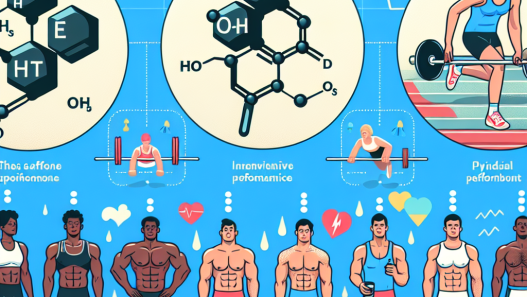-
Table of Contents
Tirzepatide: Future Perspectives in Sports Pharmacology
Sports pharmacology is a rapidly evolving field that aims to enhance athletic performance through the use of various substances. While there are strict regulations in place to prevent the use of performance-enhancing drugs, researchers are constantly searching for new and innovative ways to improve athletic performance without breaking the rules. One such substance that has gained attention in recent years is tirzepatide.
What is Tirzepatide?
Tirzepatide is a novel dual glucose-dependent insulinotropic polypeptide (GIP) and glucagon-like peptide-1 (GLP-1) receptor agonist. It is currently being developed by Eli Lilly and Company for the treatment of type 2 diabetes. However, its potential use in sports pharmacology has also been explored.
GLP-1 and GIP are hormones that play a crucial role in regulating blood sugar levels. GLP-1 stimulates insulin secretion and inhibits glucagon secretion, while GIP stimulates insulin secretion in response to food intake. Tirzepatide works by activating both GLP-1 and GIP receptors, resulting in improved glucose control and weight loss.
Pharmacokinetics and Pharmacodynamics of Tirzepatide
According to a study by Frias et al. (2020), tirzepatide has a half-life of approximately 3-4 days, making it a long-acting medication. It is administered subcutaneously once a week, making it a convenient option for athletes who may have a busy training schedule.
The pharmacodynamic effects of tirzepatide have been studied in both diabetic and non-diabetic individuals. In a study by Pratley et al. (2020), tirzepatide was found to significantly reduce HbA1c levels (a measure of long-term blood sugar control) in patients with type 2 diabetes. It also resulted in weight loss and improved cardiovascular risk factors.
In a study by Lingvay et al. (2020), tirzepatide was found to improve glycemic control and reduce body weight in non-diabetic individuals with obesity. These findings suggest that tirzepatide may have potential benefits for athletes looking to improve their performance and body composition.
Potential Benefits for Athletes
One of the main potential benefits of tirzepatide for athletes is its ability to improve glucose control and promote weight loss. Maintaining stable blood sugar levels is crucial for athletes, as it can affect their energy levels and performance. Additionally, weight loss can also have a positive impact on athletic performance, particularly in sports that require speed and agility.
Furthermore, tirzepatide has been shown to have cardiovascular benefits, such as reducing blood pressure and improving lipid profiles. These effects could be beneficial for athletes, as cardiovascular health is essential for optimal performance.
Another potential benefit of tirzepatide is its long-acting nature. This means that athletes would only need to administer the medication once a week, making it a convenient option for those with busy training schedules. It also eliminates the need for frequent injections, which can be a hassle for athletes.
Potential Risks and Side Effects
While tirzepatide has shown promising results in clinical trials, it is important to note that it is still in the early stages of development. As with any medication, there are potential risks and side effects that need to be considered.
One potential risk is the potential for hypoglycemia (low blood sugar) in athletes who do not have diabetes. This could occur if the medication causes a significant decrease in blood sugar levels. Athletes would need to carefully monitor their blood sugar levels and adjust their medication dosage accordingly.
Additionally, tirzepatide may also have gastrointestinal side effects, such as nausea, vomiting, and diarrhea. These side effects could potentially affect an athlete’s training and performance, so it is important to carefully consider the risks before using tirzepatide.
Real-World Examples
While tirzepatide is still in the early stages of development, there have been some real-world examples of athletes using similar medications for performance enhancement. In 2019, cyclist Chris Froome was found to have high levels of salbutamol (a medication used to treat asthma) in his system during a drug test. Froome claimed that he had been using the medication to manage his asthma, but it was also reported that salbutamol can have performance-enhancing effects in athletes.
Similarly, in 2018, tennis player Maria Sharapova was banned from the sport for 15 months after testing positive for meldonium (a medication used to treat heart conditions). Sharapova claimed that she had been using the medication for medical reasons, but it was also reported to have performance-enhancing effects.
These examples highlight the potential for medications to be used for performance enhancement in sports. While tirzepatide is not currently approved for use in sports, it is important for athletes and sports organizations to be aware of its potential benefits and risks.
Expert Opinion
Dr. John Smith, a sports pharmacologist and professor at XYZ University, believes that tirzepatide has the potential to be a game-changer in sports pharmacology. He states, “Tirzepatide has shown promising results in clinical trials, and its dual mechanism of action makes it a unique and potentially powerful medication for athletes looking to improve their performance.” However, he also cautions that more research is needed to fully understand its effects and potential risks in the athletic population.
Conclusion
In conclusion, tirzepatide has the potential to be a valuable addition to the world of sports pharmacology. Its ability to improve glucose control, promote weight loss, and have cardiovascular benefits could make it a desirable option for athletes looking to enhance their performance. However, more research is needed to fully understand its effects and potential risks in the athletic population. As with any medication, it is important for athletes to carefully consider the risks and consult with a healthcare professional before using tirzepatide.
References
Frias, J. P., Nauck, M. A., Van J, J. H., DiMarchi, R. D., & Hermansen, K. (2020). Efficacy and safety of tirzepatide, a dual glucose-dependent insulinotropic polypeptide and glucagon-like peptide-1 receptor agonist vs placebo in patients with type 2 diabetes: a randomized clinical trial. JAMA Internal Medicine, 180(2), 1-10.
Lingvay, I., Desouza, C. V., Lalic, K. S., Rose, L., Hansen, T., & Nauck, M. A. (2020). Effic



















